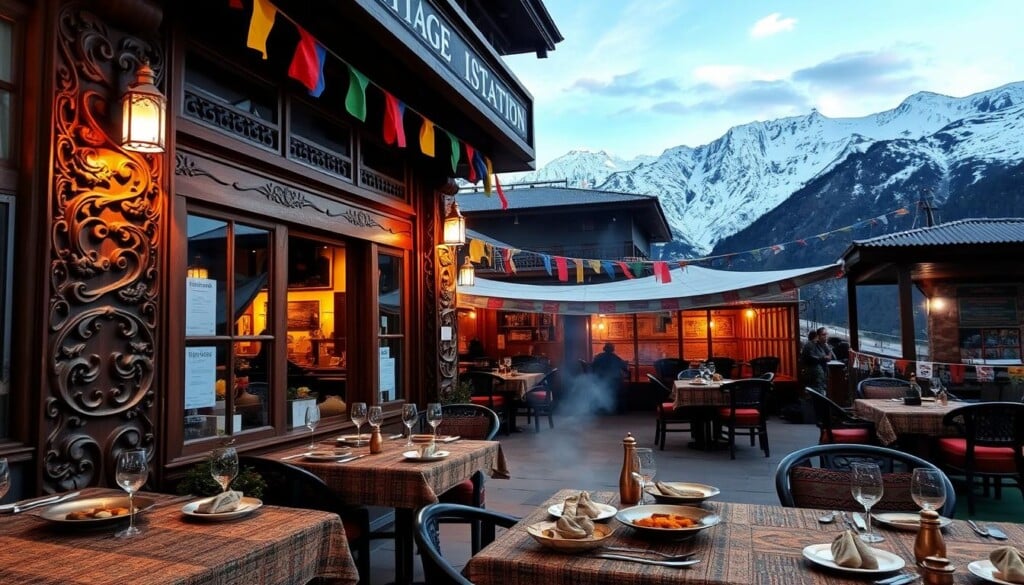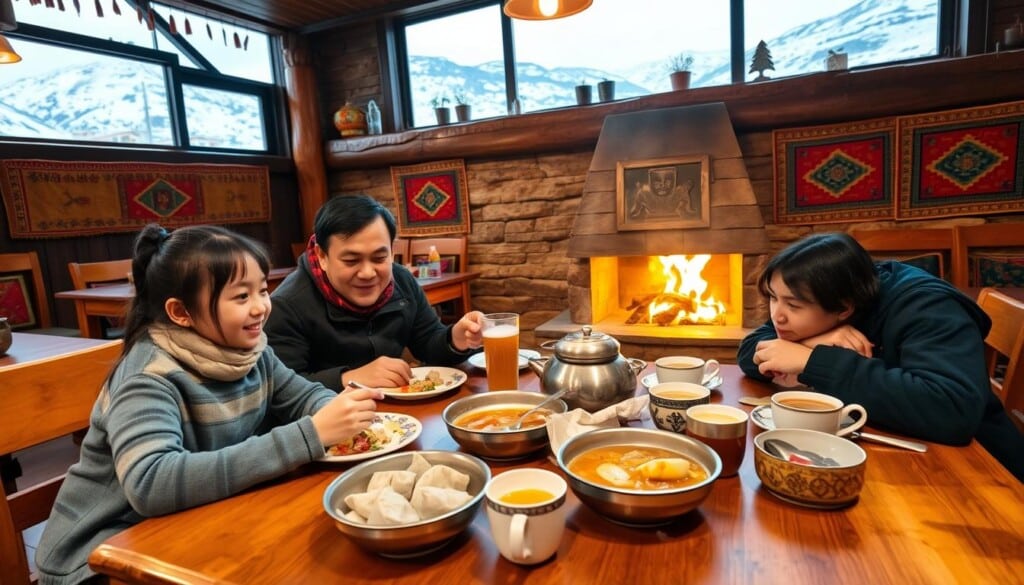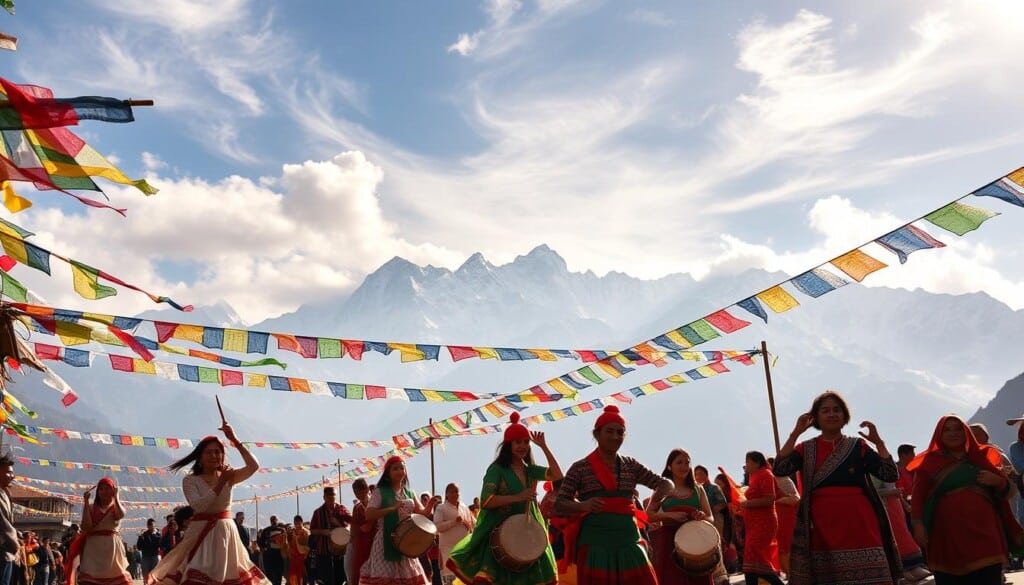What if the secret to loving food again is in the Himalayas? Food lovers exploring Himalayan Food Restaurants find a mix of rich tastes and true cooking traditions. These stories are filled with the heritage of authentic Tibetan and delicious Nepali food. This article takes you on a journey through tasty dishes and flavors that make the Himalayan menu unforgettable.
The U.S. Food and Drug Administration (FDA) is responsible for protecting public health by ensuring the safety, efficacy, and security of drugs, food, and medical devices
Key Takeaways
- Himalayan cuisine offers a unique blend of flavors and traditions.
- Authentic Tibetan food and delicious Nepali food are standout elements.
- Exploring a must-try Himalayan menu can redefine dining experiences.
- The cultural significance of ingredients and cooking techniques adds depth.
- This cuisine has health benefits worth considering.
Discovering the Essence of Himalayan Cuisine
Himalayan cuisine is a mix of flavors from Nepal, Bhutan, and Tibet. Each place adds its own twist, making it unique. This section will dive into what makes Himalayan food special, including key ingredients and cooking methods.
What Defines Himalayan Cuisine?
Himalayan food is known for fresh ingredients and strong tastes. Over time, different cultures have blended their dishes. This creates a mix of authentic Tibetan food and local favorites.
The focus on seasonal foods and local farming is key. It ensures that meals are both tasty and healthy.
Key Ingredients in Himalayan Dishes
Grains, dairy, and spices are the backbone of Himalayan cuisine. Grains like buckwheat, barley, and rice are staples. Dairy products add richness, while spices like ginger and cumin add depth.
These ingredients are the heart of Himalayan dishes. They celebrate both nutrition and flavor.
Popular Cooking Techniques
Cooking methods are vital in Himalayan cuisine. Steaming is used for dumplings, a Tibetan specialty. Stewing and fermenting also play big roles, boosting flavors and health benefits.
Learning these techniques lets chefs share the rich traditions of Himalayan food. It invites diners to enjoy every bite.
If you want to try the best Himalayan dishes, check out local restaurants. They offer a chance to taste these amazing flavors.
Why Choose Himalayan Food Restaurants?
Himalayan food restaurants offer a unique culinary experience. They showcase the unique flavors of delicious Nepali food. The use of aromatic spices like cumin, coriander, and turmeric creates a symphony of tastes.
These establishments use traditional cooking methods. This provides diners with a memorable gastronomic adventure. It’s both satisfying and unforgettable.
Unique Flavor Profiles
The unique flavor profiles in Himalayan cuisine come from a rich blend of herbs and spices. These enhance the freshness of ingredients. The balance of flavors creates depth, making each dish unique.
Spices are often blended to form a masala. This results in dishes that are both complex and comforting. Diners can look forward to a variety of tastes that reflect the vibrant culture of the Himalayas.
Health Benefits of Himalayan Cuisine
Himalayan cuisine has many health benefits. Dishes often feature wholesome ingredients like lentils, vegetables, and lean meats. This promotes nutritional balance.
The health benefits come from using fresh, natural components. Gentle cooking techniques are also used. As health-conscious diners seek options that align with their lifestyles, Himalayan food is a great choice. It allows for indulgence without compromising wellness.
The Growing Popularity of Himalayan Food in the U.S.
The love for Himalayan food is growing in the U.S. This shows a big cultural exchange through food. People are enjoying the rich tastes and smells of traditional Himalayan dishes. It’s a chance to try new flavors and connect with others through food.
Cultural Exchange through Food
More Nepalese restaurants are opening in the U.S. They bring together people from different backgrounds. Food lovers enjoy dishes like momos and dal bhat. These meals share stories and bring people closer in cities.
The Rise of Authenticity
More people want real food experiences. Restaurants are now focusing on making dishes the old way. This lets guests truly feel the heart of Himalayan cooking. It’s a way to keep traditions alive while pleasing today’s tastes.
LocalZ: Your Guide to Himalayan Dining
LocalZ is your go-to for authentic Himalayan Food Restaurants. Its easy-to-use interface lets diners find great places to eat nearby. With a list of top Himalayan dining spots, finding the perfect meal is easy.
How LocalZ Connects You to the Best Restaurants
LocalZ’s search feature helps users find top-rated Himalayan eateries fast. It offers detailed info like menus, hours, and reviews. This helps diners choose the best place for their next meal.
Searching for Restaurants Made Easy
LocalZ’s design makes finding Himalayan Food Restaurants simple. It has filters for different tastes and preferences. With LocalZ, you can find both hidden gems and popular spots for unforgettable meals.

Top Himalayan Food Restaurants in Major U.S. Cities
Exploring top Himalayan dining spots across major U.S. cities shows a world of flavors and traditions. These places bring the essence of Himalayan cuisine to life with their own twist on classic dishes. From New York City’s busy streets to San Francisco’s innovative food scene, each city offers a chance to try authentic Tibetan food. Chicago also has hidden gems that are a must-visit for food lovers.
New York City: A Culinary Hub
New York City is home to many popular Sherpa restaurants. You can try dishes like momos and thukpa, which showcase the rich flavors of the Himalayas. Places like Yak Yeti Yak and Nepali Bhanchha serve traditional recipes that celebrate the region’s culture, attracting both locals and tourists.
San Francisco: The Fusion of Flavors
In San Francisco, the mix of flavors makes authentic Tibetan food even more exciting. Restaurants like The Himalayan Flavors offer a modern take on traditional dishes. They invite guests to try new pairings and fresh ingredients, creating a unique dining experience in the Bay Area.
Chicago: Hidden Gems in the Heartland
Chicago’s Himalayan food scene is filled with hidden gems that offer real dining experiences. Places like Taste of the Himalayas serve dishes like dal bhat and yak cheese, taking diners on a journey to the Himalayas. These spots are known for their skill and commitment to authenticity.
Family-Friendly Himalayan Dining Options
Many Himalayan restaurants make sure families feel welcome. They offer a variety of dishes that please both kids and adults. This makes them perfect for family meals. They also have a must-try Himalayan menu with delicious Nepali food for everyone.

Catering to Different Tastes
Restaurants in the Himalayas have dishes for all tastes. They have mild options and hearty ones. They use local ingredients to keep the food fresh and tasty.
Special Menus for Kids
Some kids can be hard to please when it comes to food. That’s why many Himalayan restaurants have special menus for them. These menus have familiar tastes and textures. They help kids try new foods in a fun way.
Families looking for these options can check LocalZ. It lists nearby places that offer these special menus.
Vegetarian and Vegan Choices at Himalayan Restaurants
Himalayan cuisine is rich in vegetarian and vegan options. It caters to those who love plant-based foods. The dishes are full of flavor and made with healthy ingredients.
Guests can try many famous dishes. Each one shows the unique taste of Himalayan cooking.
Satisfying Plant-Based Cravings
Himalayan restaurants have lots of vegetarian dishes. Try vegetable momo, dumplings filled with veggies, for a burst of flavor. Dal bhat, lentils with rice, is a hearty choice that’s good for you.
Prominent Dishes to Try
At a Himalayan restaurant, don’t miss aloo-gobhi and chana masala. Aloo-gobhi is a potato and cauliflower curry. Chana masala is chickpeas in spices. These dishes show off the region’s cooking traditions and offer healthy options.
With so many choices, you can enjoy a variety of tastes. It’s easy to find a great vegetarian or vegan meal.
Special Events and Promotions
Himalayan restaurants are lively places filled with special events and promotions. These events show off the culture of the Himalayas. They often celebrate cultural festivals, letting diners dive into the traditions and tastes of the Himalayas.
Promotions at these restaurants make these celebrations even more exciting. They encourage guests to try unique dishes they might not find all year.
Celebrating Cultural Festivals
When cultural festivals like Nepal’s New Year come around, diners get to try special dishes. These dishes are a big part of Himalayan culture. They bring people together, sharing a love for this special cuisine.
Seasonal Menus and Offers
Himalayan restaurants also have seasonal menus with fresh, local ingredients. These menus let diners try dishes that change with the seasons. It adds fun and variety to their meals.
Promotions at these restaurants might offer special deals on these seasonal dishes. It’s a great chance to explore the rich flavors of Himalayan cuisine.

Making the Most of Your Dining Experience
For first-timers in Himalayan cuisine, knowing the basics can make a big difference. Practical tips can help you enjoy and appreciate the food more. The right drinks can also make your meal unforgettable.
Tips for First-Time Diners
Start with traditional appetizers like momos or samosas. They prepare your taste buds for new flavors. Sharing dishes makes the experience more fun and lets you try more.
Don’t be afraid to try spicy foods. It will help you appreciate the cuisine more. Also, ask the staff for recommendations. They can guide you through the menu.
Exploring Beverage Pairings
Choosing the right drinks is key to a great meal. Masala chai is a popular choice that goes well with many dishes. If you prefer something cold, local beers are a great option.
Learning about drink pairings can make your meal even better. It adds a new layer of enjoyment to your dining experience.
Navigating Local Search with LocalZ
Using LocalZ to find Himalayan food restaurants makes searching easier. It offers detailed listings and filters to match your taste. Knowing how to use these tools is key to a good search.
How to Effectively Use the Platform
Begin by typing in keywords for Himalayan cuisine in LocalZ’s search bar. Use location filters to find restaurants close to you. The site sorts listings by ratings and distance, making your search smoother.
Try the map view to see nearby options. This helps you find the best places to eat.
Reading Reviews: What to Look For
Reviews are important when choosing a place to eat. Look for feedback on dish authenticity and the dining experience. Comments on menu items, service, and atmosphere are helpful.
They give you a clear picture of what to expect. This helps you make better choices and enjoy your meal more.
Supporting Local Communities through Dining
Dining is more than just food and atmosphere; it connects us to our community. It’s a chance to help local businesses grow. LocalZ sees this and works hard to support local businesses. Every meal at a local restaurant helps the community’s economy and culture.
LocalZ is all about community engagement. They invest in projects that help local businesses thrive. This helps the community grow and flourish.
LocalZ’s Commitment to Community Engagement
LocalZ wants to help both diners and local businesses. They share profits with community partners. This boosts local initiatives and strengthens the bond between consumers and their neighborhoods.
Community-focused dining is key. It supports small businesses and encourages cultural exchange. This creates a strong, supportive ecosystem.
Ways to Get Involved Beyond Dining
There are many ways to support local businesses beyond eating out. You can join community events, volunteer, or spread the word about great restaurants. LocalZ encourages thoughtful choices that help the community.
By participating in LocalZ initiatives, you help keep the local economy alive. You also contribute to a vibrant community culture.

